Appendix 2
The Families of Shung Him Tong in 1932
Most family histories of early Shung Him Tong villagers begin with a genealogy, followed by an account of their conversion to Christianity and their reasons for moving to Shung Him Tong. In these histories, several patterns emerge: most of the settlers were Christian before they arrived, and those who were not converted shortly after arrival; the first settlers were mostly from the Baoan region of Guangdong and all were Hakka; and, in almost all cases, disturbances in their native villages spurred their emigration to the reputedly more peaceful, British-governed New Territories. Almost all of the histories stress the positive factors of moving to a Christian village.
Ling Kai Lin (see fig. 2)
There are several sources on the history of the Ling family, the most detailed of which was written by Ling Sin Yuen, the eldest son of Kai Lin, and is included in the Pang volume (see Pang 1934; Luo 1965; Lin[g] 1974). Some relatives of Ling Kai Lin in Hong Kong provided helpful information, and I was also able to obtain several articles about the family written by Lin[g] Dou Yeung, the son of Ling Sin Yuen.[1] Although he lived in the United States, Ling Dou Yeung was still an elder of Shung Him Church in 1987.
Ling Sin Yuen begins his family history by recounting the belief that if a person does not know his ancestors he will be worse than an animal, and that one should trace his family history as far back as possible. He traces the Ling history back to Kat in Jiangxi province, Cheung who moved to Meixian in Guangdong province, and Yat Lam who moved to Buji, Baoan. Ling Kai Lin is the fifth-generation descendant of Yat Lam; the first four were Yuk Bun, Wan Choi, Chiu Shui, and Chun Ko. Chun Ko was the father of Kai Lin. Chun Ko was a "simple and honest" person who "worshiped idols" until he was forty, when he learned of Christianity from the Basel missionary Hamberg.
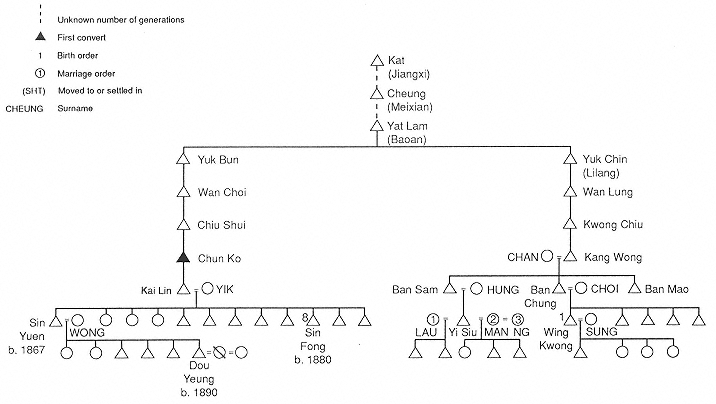
Figure 2.
Ling Genealogy.
He then "left the idols and became devoted to the true God. He and his family were baptized and became Christians" (Pang 1934:39).
However, hatred of Christianity grew among the villagers and Christians suffered persecution. The missionaries were expelled from the village, so they left for Lilang, where they established a school and taught the Bible. Kai Lin entered that school and after graduation went with his wife to Zhangcun in Wuhua, where he worked for twelve years. Later, concerned for his parents because he had no brothers who could take care of them, Kai Lin applied to return to his native village. He wanted to "look after his parents and fulfill his duty as a son" (Pang 1934:40). His application for a transfer was approved, but when he reached home the plans had been changed and he was sent to Chang Shan Kou. At that time he wrote the following poem expressing his sadness at leaving his parents, and his commitment to his calling:
Just as I unload my saddle at my native village
Then I must lead my horse to Chang Shan.
If not to spread truth and obey divine orders,
How could I leave my home and my father's face?
According to Ling Sin Yuen, Kai Lin's aspiration to sacrifice himself to others and transform his filial piety into loyalty to God was clearly revealed in the poem (ibid.).
Kai Lin stayed in Chang Shan Kou for three months and then was sent to Guzhu, where a new church was being built. After living there for six years, he went back to Lilang, where he devoted himself to the church for another thirty-six years. In the words of Sin Yuen, Kai Lin raised his children and worked for the church, endured hardships, and spared no effort in performing his duty. At fifty-seven he retired and returned home, but his passion for helping others never left him. He raised enough money to build a church and school in his village, but he was not happy there because it was not a peaceful place. He "founded" Shung Him Tong in 1903 and thereafter enjoyed a peaceful life in Lung Yeuk Tau, returning to his native village only for visits. In 1918, at age seventy-four, he returned to his native place, where he died and was buried. His wife (surname Yik) died in Shung Him Tong at the age of ninety in 1932 and was one of the first people to be buried in the Shung Him Tong cemetery.
Ling Ban Chung (see fig. 2)
The family of Ling Ban Chung was poorer, less educated, and did not become Christian until much later than Ling Kai Lin's family. They became Christian after coming to Shung Him Tong and worked mostly as farmers.
Ling Ban Chung's genealogy branches, like Ling Kai Lin's, from that of their common ancestor, Ling Yat Lam, who moved within Guangdong province
from Meixian to Buji, Baoan. Yat Lam's sons were Yuk Bun and Yuk Chin. Yuk Bun was Kai Lin's great-great-grandfather and Yuk Chin was Ban Chung's. Yuk Chin moved to Lilang and was the father of Wan Lung. Wan Lung's son was Kwong Chiu, and Kwong Chiu's son was Kang Wong. Kang Wong married a woman whose surname was Chan and their three sons were Ban Sam, Ban Chung, and Ban Mao. It is not clear whether Ban Sam and Ban Chung were Christian but several members of the following generation credit Pastor Ling Kai Lin with their conversion.
Ban Chung was from Lilang, Baoan. He heard about Lung Yeuk Tau from a neighbor, and in 1898 moved with his family to Ma Wat village in Lung Yeuk Tau. In 1899 the Lung Yeuk Tau Teng protested against the British acquisition of the New Territories, and during the disturbances Ling returned briefly to Lilang. But within the next few years he returned to Lung Yeuk Tau and settled in Shung Him Tong.
Pang Lok Sam (see fig. 3)
Pang Lok Sam begins his family history with his great-grandfather Sing Fu and his great-grandmother (surnamed Ho), who lived as farmers in Longhua, Baoan. His grandfather and grandmother (surnamed Cheung) ran a business, and his father and mother (surnamed Wong) worked in the Longhua market.[2] Pang Lok Sam's parents learned of Christianity, and in 1879 they were baptized nearby in the Langkou church. Pang Lok Sam was born in 1875 and baptized when he was four years old. When he was eight, his father died and his mother began to work as a housekeeper for Basel missionaries. He went on to mission-run schools: primary school in Lilang, secondary school in Wuhua, and then Lilang Seminary, from which he graduated in 1896 and took up missionary work. In 1899 he married Tsui Dou Leung from Zhankeng, Wuhua, with whom he had twelve children. After working two years at the Zhankeng church, Pang Lok Sam was transferred to a church in Zijin. In 1901 his youngest brother died. His mother was heartbroken, and to console her he applied to the mission for a transfer to Baoan to be closer to her. He was transferred to Tai Po and later Sha Tau Kok in the New Territories. In 1905 he began to preach in Shung Him Tong but also continued to work in Tai Po, Nam Wa Po, and Sha Tau Kok.
Pang played an active role in the development of the village and in New Territories politics and was involved in the founding of the Heung Yee Kuk. He was personal friends with Sir Cecil Clementi during the latter's years as district officer and later his governorship. Pang was awarded the Coronation Medal (Ingrams 1952:170), and was also one of the originators of the plan for establishing the Luen Wo market in Fanling. Before the market was
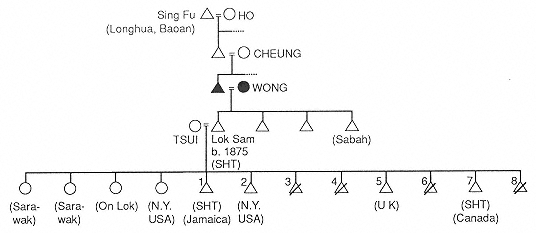
Figure 3.
Pang Genealogy.
established, people from Fanling did their marketing in Sheung Shui at Shek Wu Hui. But the fees collected from vegetable hawkers were spent on social welfare projects in the Sheung Shui area and did not benefit the people of Fanling. The Luen Wo market was completed in the early 1950s and is run primarily by the Punti Pang of Fanling. Pang died in 1947 and did not live to see the market fully developed.
It was because of Pang that the family of Tsui Yan Sau decided to settle in Shung Him Tong. Pang's wife was the sister of Yan Sau, making Tsui and Pang brothers-in-law. Tsui was a direct descendant of the first Basel mission convert in Wuhua.
Tsui Dou Leung (see fig. 4)
The Tsuis all trace their ancestors back to the district of Wuhua in Guangdong. Chung Lai moved from the town of Wuhua to the nearby village of Zhankeng. Fuen Po was born in the ninth generation after Chung Lai. When Fuen Po heard of the mission station in Zhangcun, Wuhua, he went there to learn more about God. At that time many people were opposed to Christians and considered Chinese converts to be followers of the barbarians. Fuen Po was baptized in Zhangcun and, despite ill treatment from his neighbors, stuck to his beliefs.
Fuen Po worked as a farmer and had four sons and two daughters. His sons were Wung Nam, Wung Cheung, Wung Kwong, and Wung Mo. The fourth son, Wung Mo, baptized "Dou Leung," studied at missionary schools, later graduated from the seminary in Lilang, and went to teach at a mission school in Meixian. Dou Leung had eleven children, several of whom settled in Shung Him Tong. After Dou Leung resigned from teaching, he went to Xingning to "do business" and then to Hong Kong to expand the business.
Dou Leung brought his son Yan Sau with him to Hong Kong and began to raise pigs on the southeastern side of the island. When Yan Sau was about ten years old, while playing on the beach, he met some Catholic priests who taught at Saint Joseph's College. They invited Yan Sau to attend classes at St. Joseph's, where he converted to Catholicism, finished secondary school, and taught for several years after his graduation. Yan Sau married the daughter of his father's close Basel mission coworker; the marriage had been arranged when he was a child. Although Yan Sau was Catholic, his wife remained Protestant and became a model elder of Shung Him Tong (Cheung 1984). In 1919 Yan Sau founded Wah Yan College, one of the most renowned schools in Hong Kong. In 1924 Tsui asked his brother-in-law Pang to help him find a place to build a house. Sehk Louh, the Tsui's house, was built in 1925 and
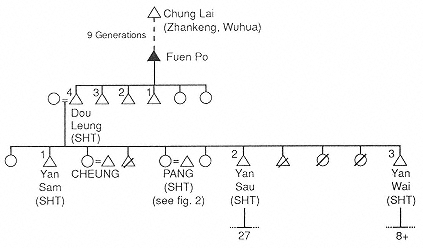
Figure 4.
Tsui Dou Leung Genealogy.
Dou Leung came to live there with Yan Sau's family. In 1926, Yan Sau's younger brother, Yan Wai, brought his wife and children to Shung Him Tong and worked for his brother as a teacher at Wah Yan College. Later, the family of Yan Sam—Yan Sau and Yan Wai's eldest brother—also settled in Shung Him Tong.
Tsui Kwong Chung and Tsui Kwong Wing (see fig. 5)
Tsui Kwong Chung's and Tsui Kwong Wing's families were both from Zhankeng, Wuhua. Their common ancestor was Man Ho, who had five sons. The third son, Fa, had a grandson named Shuen Shung; Shuen Shung's son was Kiu Sin; Kiu Sin was the father of Kwong Chung.
Kwong Chung was not happy with life in his native village so he applied to his great-uncle Tsui Yan Sau to come and work as a janitor at Wah Yan College. In 1928 he brought his wife (surname Cheung) and his son Shui Kun and his son's wife to Hong Kong. A few years later he decided he would someday like to live in Shung Him Tong. He discussed the matter with his cousin Kwong Wing, who was already living in the Fanling area and, with the help of Pang, they built houses there in 1931. Kwong Chung and his family were Christian.
Kwong Wing's great-great-grandfather was Pit Fat. His son was Sin Hong. Sin Hong's son was Yuek Sut and Yeuk Sut's sons were Kwong Wing and Kwong Yuet. All of Yuek Sut's descendants were Christian, and they all
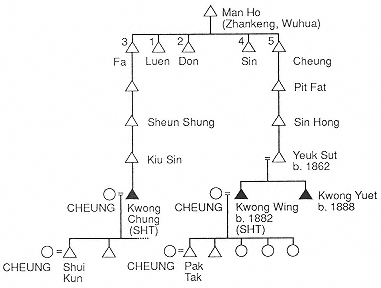
Figure 5.
Tsui Kwong Chung and Tsui Kwong Wing Genealogy.
worked in Wuhua as farmers. After 1910 a feud broke out between them and a Cheung family: "The two families fought with guns and after that my family began to decline…. The situation was not good; there were often robberies; the government was corrupt; the gentry persecuted us; and the village was small and crowded … and there was no fertile land" (in Pang 1934:101). Kwong Wing went to work for the missionary school in Lilang, and during the summers he worked as a servant for Pang Lok Sam. When the school was relocated in Xingning, Kwong Wing hoped to move to Shung Him Tong and was promised Pang's help. In 1925, Kwong Wing started off to Wuhua to fetch his family, but on his way through Ping Shan in the New Territories he was robbed. He returned to Lung Yeuk Tau, where he borrowed money from Pang and rented a house and some land to farm in Po Kat Tsai. When his family arrived, he continued farming there for six years until 1931, when he moved to Shung Him Tong with his cousin Kwong Chung.
Cheung Wo Ban (see fig. 6)
Cheung Ka Yuen moved from a village near Boluo, Huizhou district, to Pa Mon village, in Baoan. Later he moved from Pa Mon to Ma Hom, also in Baoan. Cheung Wo Ban's great-uncle Kong Ban was baptized by Basel missionary Lechler. Wo Ban's father To Po was also Christian; thus, at age
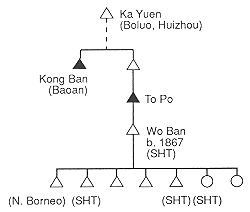
Figure 6.
Cheung Wo Ban Genealogy.
ten, Wo Ban entered the missionary school in Lilang. At sixteen he went to secondary school in Wuhua, and at twenty attended Lilang Seminary. In 1890, when he was twenty-three, he was sent to work as a missionary in Zijin. He remained there until 1899 when he was sent to Kwai Chung, Baoan, and then to teach at the Langkou school in Lilang. He remained there for nine and a half years until he was sent to Shung Him Tong in 1913.
Cheung did missionary work in Shung Him Tong and was the first teacher at Chung Him School. By the time he had been in Shung Him Tong a few years, he had no desire to return to his native village, which was poor and remote. Many of his relatives had already emigrated to Sabah, so instead of returning to Baoan, he decided to settle permanently in Shung Him Tong, and in 1928 he built a house there.
Wo Ban's eldest son worked in the government office in Sabah, North Borneo. His second son was a minister; his third son was a teacher; his fourth son worked for a mining company; and his fifth son worked in the Hong Kong British Government Lands Office.
Cheuk Hing Ko (see fig. 7)
Like Pang, Cheuk Hing Ko was from Longhua, Baoan. His ancestors moved there from Sai Lam, Wuhua. Hing Ko's grandfather had four sons, the second of whom he called Wah Sing, who in turn had a son named Hing Ko. Wah Sing was converted by Rhenish missionaries who had established a station in Langkou. Hing Ko attended a Rhenish mission school and then opened a shop in Shen Zhen. Later he moved back to Longhua and opened a grocery and medicine shop and a mortgage company. Business went well but one day his
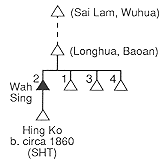
shop was burglarized, so he moved to Sai Ying Pun, Hong Kong. After some time he returned to Longhua, but did not feel safe there. He had heard of Shung Him Tong because he knew of Pang Lok Sam and Ling Sin Yuen and knew that, like him, they were Christian. In 1917 he built a house in Shung Him Tong and traveled back and forth between there and Longhua. He died in the 1920s and in 1931 only two of his daughters and his youngest son remained in Shung Him Tong.
Yao Dou On (see fig. 8)
Yao Dou On was a native of Huiyang. As a child he came to Hong Kong with his mother and attended the Sham Shui Po charity school. He became Christian and after graduation went to work on a customs ship. He became known as Iron Man for resisting corruption on the ship. Yao's wife (surname Wong) was the sister of the wife of Ling Sin Yuen. While Dou On lived with his wife, daughter, and three sons in Sham Shui Po, Rev. Ling Sin Yuen worked at the Basel mission church there. Yao Dou On mentioned to Ling that they would like to live in the country, and Ling recommended that they move to one of the vacant houses in Shung Him Tong. They moved there in 1927.
Chan Cheong Wo (see fig. 9)
Today there are many families of the surname Chan living in Shung Him Tong, but most are not related to those who were there in the early period of village history.
Chan Man Sing and Chan Chin Kung's ancestors had lived in Baoan in a place called Lilang for many generations before the family members scattered to other regions. Cheong Wo moved to Tsz Tong village in Lung Yeuk Tau and later to Shung Him Tong. He had two sons, Yuk Chuen (Choi?) and

Figure 8.
Yao Dou On Genealogy.
Kwai Choi. Yuk Chuen married a woman named Wong who gave birth to a daughter and then died. He then married a woman named Tsang and they had two sons and three daughters. All of them became Christian. Kwai Choi went to America and was baptized there. He married a woman named Lo and they had five sons. After Lo died, he returned with his children to Shung Him Tong. He remarried a woman by the name of Yao and they had a son and a daughter. By 1930 two of the sons had gone to America and the others lived in Shung Him Tong.
Tsang Ting Fai (see fig. 10)
Along with the Cheuks and Chans, the Tsangs are no longer represented among the present residents of Shung Him Tong. Tsang Ting Fai's ancestors were from Wuhua, but at the beginning of the Qing dynasty (1644) some family members moved to Huiyang. Yat Kin moved to a village in Longgang. There he raised a family, started an ancestral hall, and farmed the land. He married a woman named Lam with whom he had three sons, each of whom lived in separate houses in the same village. The eldest son, Lap Bun, married a
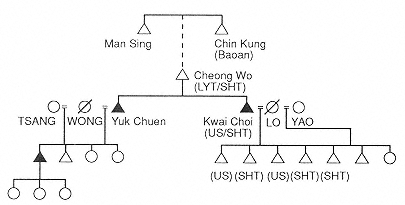
Figure 9.
Chan Cheong Wo Genealogy.
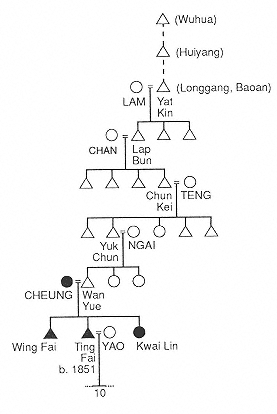
Figure 10.
Tsang Ting Fai Genealogy.
woman surnamed Chan and had four sons. The youngest son, Chun Kei, married a woman named Teng and had four sons and a daughter. Yuk Chun, the second son, married a woman named Ngai and they had a son and two daughters. Yuk Chun's son, Wan Yue, married a Cheung and had two sons and a daughter. The sons were Wing Fai and Ting Fai, and the daughter was named Kwai Lin.
From the time the family moved to Huiyang the Tsangs were farmers. Ting Fai was born in 1851, a chaotic time of war, floods, and famine. His father died in 1865 and he and his brother were forced to discontinue their studies. At that time he and his brother, sister, and mother all became Christian. When the period of mourning for his father was over, they removed the altar and the idols from their home. In 1866 they were baptized at a Berlin mission church by the Basel missionary Hamberg. The following year Ting Fai's brother died, so at seventeen he went with his mother and sister to
Canton to continue his studies. He attended On Tak Theological Seminary and in 1876, when he was twenty-five years old, went to work as a missionary. He was introduced to a woman of the surname Yao, whom he later married at the Basel mission church in Sai Ying Pun; the ceremony was performed by Rev. Lechler. In 1880 Ting Fai went to Hawaii as a missionary and also did some business.
Ting Fai had seven sons and three daughters. After his mother died in 1902 he decided to return to his native village to preach the gospel, since few of the people there believed in Christianity. Within a year eight families had converted. He rebuilt his family's graves and built a road to connect his home with the nearby church. Then in 1903 he returned to Hawaii. On the ship en route to Hawaii he met Dr. Sun Yat-sen. In Hawaii in 1904 he began to work for the Yuet Han railroad project and also became involved in stock investment. When the fall of the Qing dynasty was imminent in 1909, the shareholders of the Kwong Mei Company requested that he return to China. In 1921 he returned to Hawaii for the third time. The following year he returned to his native village to build a house for his retirement. Three months after construction was complete, three of his kinsmen in the village were killed, and soon after five of his relatives were beaten. Many of his relatives then left for Malaysia, and Ting Fai moved to Shung Him Tong, where his good friends Pang, Ling, and Cheung had houses.